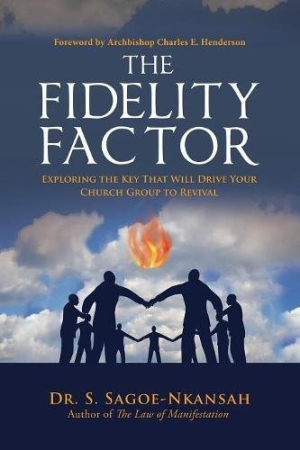The Fidelity Factor
Exploring the Key That Will Drive Your Church Group to Revival
The book’s writing style is sermon-like, drawing from real life and biblical verses for compelling calls to action.
S. Sagoe-Nkansah’s church development book The Fidelity Factor vividly explores African Christianity through its specific encouragements toward revival.
Constructed around ten milestones designed to drive revival moments—like calling, gathering, discernment, and covenant—the book seeks to generate the same kind of spirit that birthed the contemporary Pentecostal movement. Each milestone involves between three and fifteen steps—steps like “see the vision,” “initiate fidelity,” and “recognize the unspoken covenant.” Each step is clarified with more specific action items, generally including some combination of prayer, reflection, and biblical study.
The book’s lofty goal of inspiring a new religious awakening is undermined by its very specific Pentecostal focus; it loses sight of the larger Christian world. Very much a product of its origins in North Africa, its descriptions are specific to Pentecostal and charismatic church experiences. Its focus on fidelity is more universal.
The book presents fidelity as essential to church growth and observes that it can often have different faces, looking variously like zeal, passion, courage, or calling, but that it is always a characteristic of faithfulness. Sagoe-Nkansah argues that for a true revival to take place, church groups must focus on the idea of fidelity and be bound together with strong, almost familial bonds, and that leaders must know how to “measure fidelity” in the hearts and minds of others. To allow for that measurement, the book offers a series of tests, areas of discernment, and prayers designed to help leaders make determinations. The work’s strength is in its personal tone, which reflects a lived experience of revival.
The book’s earliest mentioned milestones provide the clearest guidance, including steps for determining the “calling” of a church and fostering “understanding” of fidelity. Later milestones—judgment, for example—are more fractured; they are often made up of steps and then further divided into additional biblical categories, becoming confusing in their complexity. This is compounded by a lack of narrative flow, with the format carrying the weight of the material.
The book’s writing style is persuasive and earnest. The book uses standard preaching fare. It makes its case in sermon-like fashion, setting each step up with a story from real life, followed by an exploration of a biblical verse and ending with a call to action. The book weaves together pieces of church life with biblical texts to create both a sense of drama and excitement. The book’s illustrations come alive with dialogue and fascinating characters.
The Christianity presented here is very much a mystical spirituality, which may help Christians to better understand what a revival both looks and feels like. In making a strong case for the need to re-consider fidelity as a Christian virtue, The Fidelity Factor brings a fantastic and mystical energy to church growth and development.
Reviewed by
Jeremiah Rood
Disclosure: This article is not an endorsement, but a review. The publisher of this book provided free copies of the book and paid a small fee to have their book reviewed by a professional reviewer. Foreword Reviews and Clarion Reviews make no guarantee that the publisher will receive a positive review. Foreword Magazine, Inc. is disclosing this in accordance with the Federal Trade Commission’s 16 CFR, Part 255.

